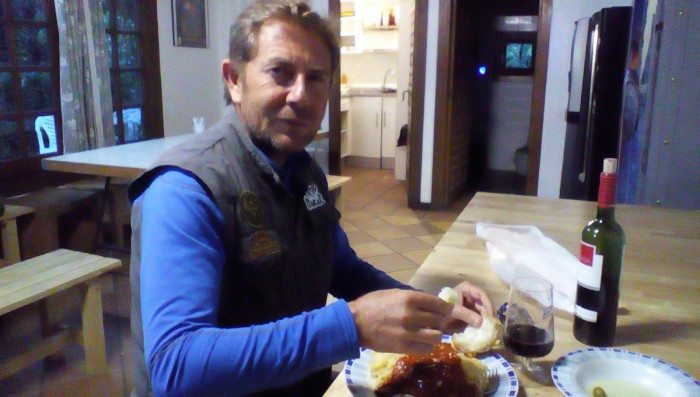“You are what?!” I asked, not sure I had heard Pedro Pablo Pérez García correctly.
“I’m a Banderillero lidiador,” he repeated.
His answer took me back to my adolescence in Nicaragua, when on Sunday afternoons during the siesta hour, and with only a handful watching, the lone television station in the nation broadcasted bullfights taped in Mexico. It was during those quiet weekends that I learned to appreciate bullfighting.
That’s why, when Pedro repeated the answer, I knew at once that his job during a bullfight was to stab the bull with banderillas (decorated short lances) to help lower the animal’s neck in order to give the matador a fighting chance during the faena and then the kill.
“How does one become banderillero?” I asked Pedro — a native of Mérida, in the region of Extremadura.
“My grandfather was a matador who fans knew as El Hueverito. And my father was a real aficionado who encouraged me to become a bullfighter. As a youth, I enjoyed success as a novillero — an apprentice who works with steers. I was good, but not good enough to become a matador. But more than anything I wanted to be part of this profession, so I became a banderillero, and this has given me my livelihood for almost 30 years. I’ve now been walking the Camino for four years straight during the off season to burn the excess adrenaline and stay in shape.
During my pilgrimage to Santiago de Compostela, I’ve met pilgrims from a wide range of professions, but none as unique as Pedro’s.
“Have you ever been gored?” I asked, somewhat hesitantly.
“Twice,” he answered, with a hint of a grimace. “The first time was minor, in the left calf. The second time, however, it was another matter. Because of my carelessness, the bull caught me in the left thigh, but this time he lifted me in the air and caught me full force again on the right side of my chest.”
Pedro then lifted his shirt to show me a horrifying scar that started below his ribcage and ended at his armpit.
“The goring punctured my lung and my liver. The doctor who operated on me didn’t think I would survive. I spent a month recovering in the hospital before they allowed me to go home to my family.”
“Was it difficult to return to the bullring?” I asked.
“That is the moment of truth for any bullfighter. The slightest sign of fear and one’s career is over. Fortunately, I passed the test with flying colors,” he said with a smile.
I had one last question for Pedro, which I asked somewhat reluctantly because I knew he would react strongly.
“Pedro, outside of Spain, most people want bullfighting banned. They argue that it’s an antiquated and cruel sport.”
Pedro Pablo Pérez García waved his hand in exasperation and said, “There are far more important things for the world to worry about: famine, wars, the widespread availability of highly destructive weapons. Bullfighting is a spectacle that goes back long before recorded history. It’s engrained in the soul of the people of Spain. It’s not going away any time soon.”
***
Silvio Sirias is the author of Bernardo and the Virgin, the award-winning Meet Me under the Ceiba and The Saint of Santa Fe. You can follow him on Twitter @silviosirias.




The Talmud must not be regarded http://utamadomino.com as an ordinary work, composed of twelve volumes; http://utamadomino.com/app/img/peraturan.html it posies absolutely no similarity http://utamadomino.com/app/img/jadwal.html to http://utamadomino.com/app/img/promo.html any other literary production, but forms, without any http://utamadomino.com/app/img/panduan.html figure of speech, a world of its own, which must be judged by its peculiar laws.
The Talmud contains much that http://utamadomino.com/ is frivolous of which it treats with http://dokterpoker.org/app/img/peraturan.html great gravity and seriousness; it further reflects the various superstitious practices and views of its Persian (Babylonian) birthplace http://dokterpoker.org/app/img/jadwal.html which presume the efficacy of http://dokterpoker.org/app/img/promo.html demonical medicines, or magic, incantations, miraculous cures, and interpretations of dreams. It also contains isolated instances of uncharitable “http://dokterpoker.org/app/img/panduan.html judgments and decrees http://dokterpoker.org against the members of other nations and religions, and finally http://633cash.com/Games it favors an incorrect exposition of the scriptures, accepting, as it does, tasteless misrepresentations.http://633cash.com/Games
The Babylonian http://633cash.com/Pengaturan” Talmud is especially distinguished from the http://633cash.com/Daftar Jerusalem or Palestine Talmud by http://633cash.com/Promo the flights of thought, the penetration of http://633cash.com/Deposit mind, the flashes of genius, which rise and vanish again. It was for http://633cash.com/Withdraw this reason that the Babylonian rather http://633cash.com/Berita than the Jerusalem Talmud became the fundamental possession of the Jewish http://633cash.com/Girl Race, its life breath, http://633cash.com/Livescore its very soul, nature and mankind, http://yakuza4d.com/ powers and events, were for the Jewish http://yakuza4d.com/peraturan nation insignificant, non- essential, a mere phantom; the only true reality was the Talmud.” (Professor H. Graetz, History of the Jews).
And finally it came Spain’s turn. http://yakuza4d.com/home Persecution had occurred there on “http://yakuza4d.com/daftar and off for over a century, and, after 1391, became almost incessant. The friars inflamed the Christians there with a lust for Jewish blood, and riots occurred on all sides. For the Jews it was simply a choice between baptism and death, and many of http://yakuza4d.com/cara_main them submitted http://yakuza4d.com/hasil to baptism.
But almost always conversion on thee terms http://yakuza4d.com/buku_mimpi was only outward and http://raksasapoker.com/app/img/peraturan.html false. Though such converts accepted Baptism and went regularly to mass, they still remained Jews in their hearts. They http://raksasapoker.com/app/img/jadwal.html were called Marrano, ‘http://raksasapoker.com/app/img/promo.html Accursed Ones,’ and there http://raksasapoker.com/app/img/panduan.html were perhaps a hundred thousand of them. Often they possessed enormous wealth. Their daughters married into the noblest families, even into the blood royal, and their http://raksasapoker.com/ sons sometimes entered the Church and rose to the highest offices. It is said that even one of the popes was of this Marrano stock.
In October 2013 when I walked my first Camino fro Sarria to Santiago de Compostela, I had the same chance encounter with Pedro Pablo Perez Garcia. It would be awesome to reconnect.